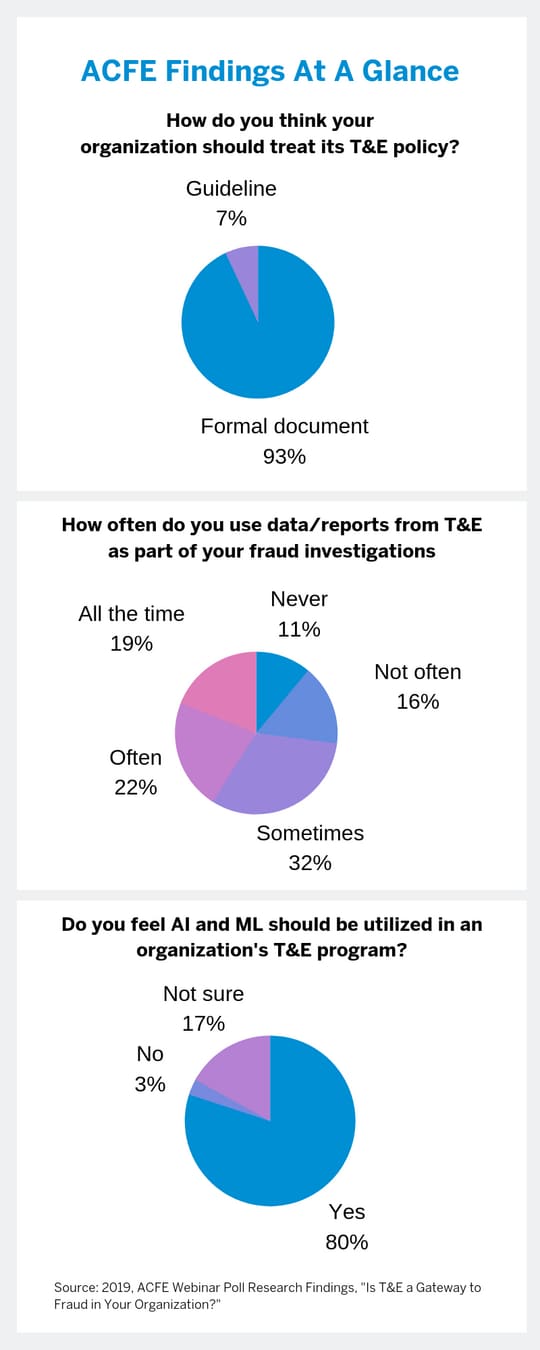Fraud and Compliance
Why Fraud Examiners Think AI and ML Should Be Used in Company Travel & Expense Programs
Teams are more strategic with AI and ML
The sheer volume of travel and expense (T&E) spending means keeping up with expenses can be overwhelming, and create an opening for fraud in your organization. Artificial Intelligence (AI) and Machine Learning (ML) are tools that members of the Association of Certified Fraud Examiners (ACFE) agree should be used in T&E programs to help combat organizational fraud. In fact, more than two-thirds (80%) of members revealed during an ACFE webcast association poll on August 12 that AI and ML should be utilized.
“Many feel you shouldn’t identify fraud the same way it was done 30 years ago. Robots make it easier,” says Connie Hoen, Program Director of Growth & Strategy and Extended Services at SAP Concur. “Some are shifting resources from searching for issues to analyzing issues using AI and ML which helps reduce cost and duration of fraud research.”
Leaning on this technology enables in-house or outsourced audit teams to focus on remediating issues and creating best practices. Spending more time in these strategic areas will benefit organizations, especially since employees are spending an increasing amount of money spread across more spend categories, and using more payment methods than ever before. “Fraudsters use multiple means to steal and pull off their schemes and many fraudsters attack the company from multiple angles,” says Andi McNeal, CFE, CPA, and Director of Research for the ACFE.
Using T&E data for fraud investigations
Certified Fraud Examiner, Kellie Lintner, CIA and CPA from Ford Motor Company, recommends organizations always do an expense report review for every individual fraud investigation. If someone is doing one fraudulent act in one area of the business, he or she is most likely cheating on expense reports as well. Having reliable, accessible data on hand to pull in further evidence is critical for investigators. This data also comes in handy for departmental investigations.
Yet, fewer than half (41%) of ACFE members are using T&E data as part of their individual or departmental investigations all the time or often. And a large majority (59%) of members may only be using this data sometimes or never because their organization doesn’t have the proper reporting or means to easily share and analyze data across multiple departments. The sheer volume of data that stems from employee-related travel and entertainment expenses can be overwhelming, especially when there is a lack of audit oversight or viable reports that others can use.
Policy: A formal document or a guideline?
Many would agree that preventing fraud often starts with the organization’s policy. However, holding employees accountable to the policy can get complicated internally, especially when the fraud is found to be intentional. Companies need to determine if the policy is really a formal document or simply a guideline. An organization’s appetite for risk, as well as its culture often determines this.
Nearly all ACFE members (93%) felt that a policy should be considered as a formal document that holds employees responsible with consequences. Only a handful (7%) considered it more of like a “guideline” with employees sometimes being held accountable with some consequences.
Many clients come up with various ways to penalize and educate employees who commit travel or expense fraud. Some have a “three strikes you’re out” policy while others leave it to the direct report’s manager to come up with the consequences. At times, human resources, legal, or compliance will intervene, especially when it’s a high dollar expense.
Curious to learn more? Contact us to see how SAP Concur helps companies prevent and detect fraud or view more of our solutions here.


